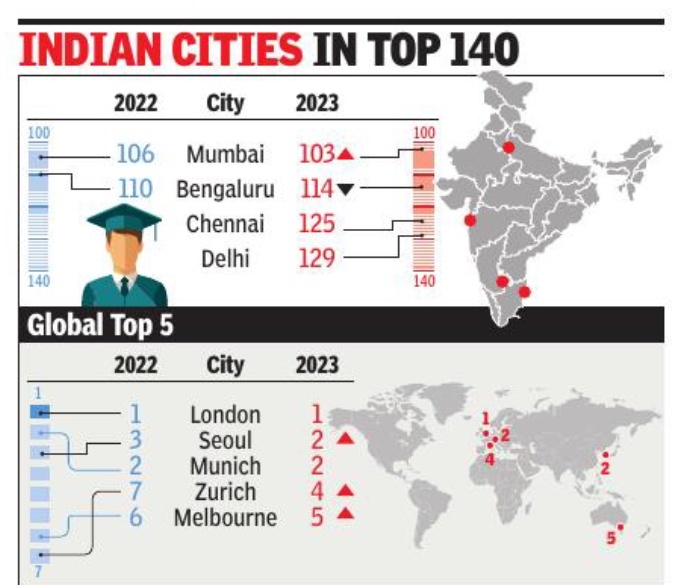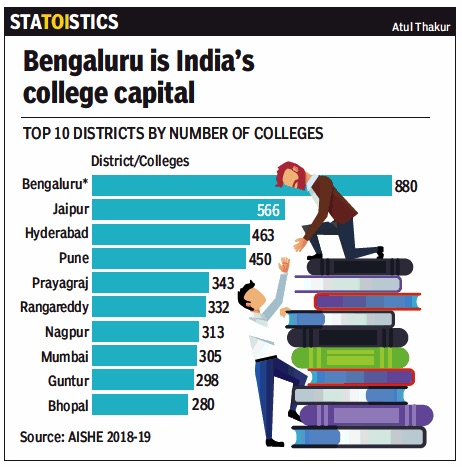Student cities, educational hubs: India
This is a collection of articles archived for the excellence of their content. |
Contents |
Annual rankings
2017
Yogita Rao, Delhi 86th among top 100 student cities: QS, Feb 16, 2017: The Times of India
Montreal World's Best, Paris Ranks Second
Mumbai, the second most affordable city in the world for students till 2016, has dropped to the 30th position this year. Delhi, on the other hand, ranks way higher at 15, states a report by Quacquarelli Symonds, compilers of the QS World University Rankings. The organisation published the 2017 list of the `top 100 student cities in the world' on Wednesday . Mumbai and Delhi rank 85th and 86th in the list, respectively .
Paris, which had topped the list since it was first compiled in 2012, was replaced by Montreal in Canada for the first time. London, ranked fifth last year, has moved up to the third position. Melbourne, on the other hand, dropped to the fifth position from second.The top five cities in Asia include Seoul, Tokyo, Hong Kong, Singapore and Kyoto-Osaka-Kobe.
Where Mumbai and Delhi managed to get higher ranks was in “employer activity“.
A city's performance is ranked on six composite indicators -affordability , desirability , student mix (international students), university ranking, employer activity and, for the first time, views of students, as in, which city would they like to study in and their willingness to continue living there.
Although an official QS statement shows that Mumbai and Delhi have seen an increase in their desirability score, these cities are still at the bottom. Mumbai is placed at the 90th position and Delhi 91th. The desirability score takes into account the quality of life, including pollution, corruption and safety .
In its inaugural rankings for 2012, QS had published the rankings for the top 50 cities. Later, it began to publish rankings of 75. This year, it has expanded the list to 100.
In 2013, Mumbai was ranked 61 and Delhi 69. Apoorva Palkar, educationist and convenor of the Maharashtra taskforce to bring about internationalisation in higher education, said, “Mumbai is increasingly seen as a preferred destination for education by foreign students despite its shortcomings. Tuition fees here are more affordable than in European institutes. However, the cost of living is high.“
2022
Manash.Gohai Manash Gohain, June 29, 2022: The Times of India

From: Manash.Gohai Manash Gohain, June 29, 2022: The Times of India
New Delhi: Chennai and Delhi join Mumbai and Bengaluru as top Indian cities for international students. In the latest QS Best Student-Cities Ranking, the four metros find place among 140 cities worldwide with Mumbai ranked highest among the Indian cities at 103, up from 106 last year followed by Bengaluru at 114. Chennai is ranked 125th while Delhi is at 129.
Globally, London, Seoul and Munich are the top three favourite destinations for international students, while Boston university of the US has been edged out of the Top 10.
According to the report, Mumbai scored high in affordability but struggles in student mix and desirability. Chennai and Delhi are the new entries to the rankings. With just 47,427 international students in Indian universities, they comprise only a small fraction of the overall student population. “But, the country seeks to attract 2,00,000 international students, more than four times the current total, by the end of 2023, a goal which may need to be reviewed as it was set prior to the pandemic, which has affected international students’ mobility,” it stated.
QS uses six metric groups to compile the “Best Student Cities Ranking”: whether the city has a range of highly-ranked universities (ranking); is this city a desirable place to live (desirability); is this city affordable for students (affordability); employer activity; and is the city a diverse and tolerant place (student mix) and do students who have actually studied in this city recommend it to their peers (student voice).
College concentrations
As in 2018-19

From: March 4, 2020: The Times of India
See graphic:
Top 10 districts by number of colleges, As in 2018-19
On-campus housing
20% of students get it/ 2019
June 8, 2019: The Times of India
Just 20% of students get on-campus housing
Mumbai:
Pune may boast of being the Oxford of the East but 1.9 lakh of the 2.6 lakh students in the city don’t get on-campus residence space. Bengaluru has the highest concentration of university colleges in India with 6.6 lakh students, of whom over 3 lakh require accommodation and almost 90% of them depend on private homes in the absence of campus housing. These are some of the findings of a Knight Frank survey released on Friday. Hyderabad, Jaipur, Nagpur, Noida, all have large migrant student populations looking for accommodation amidst their pursuit of a degree. In Jaipur especially, 85% of students are from outside the state, but just 15% of them are housed on campus. At best, only 20% of the current demand across the country is met by accommodation provided on campus by universities.
‘Most students rent flats or live in pvt hostels’
Presently, private home-owners continue to dominate the student-housing market. The majority of students either rent apartments or live in private hostels outside the university campus,” said Saurabh Mehrotra, national director of advisory services, Knight Frank India. “The quality of this accommodation is often way below what students want or expect. As such, investor interest in the market is growing with the opportunity to meet demand for well-located, highquality accommodation,” he said.
By 2020, the government wants 30% of all 18- to 23-year-olds to be enrolled in higher education courses. This would increase the country’s student population to 40 million.
The purpose-built student accommodation (PBSA) or private hostels market remains immature, with demand far outstripping supply at the current time. There are currently 1.6 million PBSA bed spaces in India, a figure which represents just 4% of the total student enrolment. The majority of this accommodation is operated outside of university control by private owners. Often, it is off-campus, of poor quality, and with little modern value-add facilities like WiFi or laundry services.
Knight Frank estimated that there is currently the potential to deliver 6 million PBSA bed spaces on greenfield land located in close proximity to universities while another 2 million can be delivered on brownfield land. The report estimated that the current demand for PBSA bed spaces across the country totals more than 8 million. Around $100 million was invested into the Indian PBSA market in 2018.